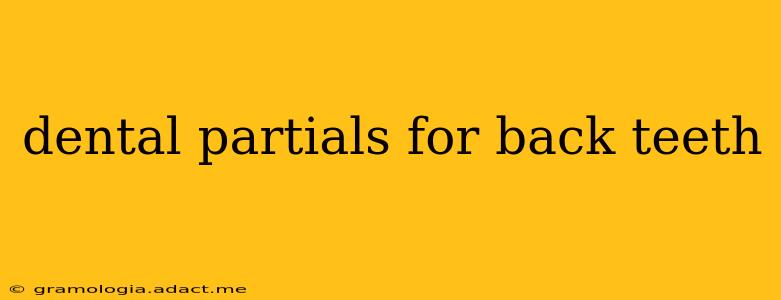Losing back teeth can significantly impact your ability to chew, speak, and even maintain the overall structure of your face. While full dentures are an option, many find partial dentures, specifically designed for the back teeth, a more comfortable and functional solution. This comprehensive guide explores the nuances of dental partials for back teeth, addressing common questions and concerns.
What are Partial Dentures for Back Teeth?
Partial dentures are removable appliances that replace missing teeth. Unlike full dentures, which replace an entire arch of teeth, partials fill gaps where teeth are missing, usually attaching to existing teeth for support and stability. When focusing on the back teeth (molars and premolars), the partial denture is designed to restore chewing function and maintain the proper alignment of your remaining teeth. These partials are often crafted from a combination of durable acrylic resin (for the gum-colored base) and metal frameworks (for strength and support), sometimes incorporating porcelain teeth for a natural appearance.
What are the Different Types of Partial Dentures for Back Teeth?
There are primarily two main types of partial dentures:
- Conventional Partial Dentures: These are the most common type and are made after all the teeth that need to be extracted have healed completely. This allows for accurate measurements and ensures a precise fit.
- Immediate Partial Dentures: These are made in advance and placed immediately after the extraction of necessary teeth. While convenient, they may require adjustments later as the gums heal and change shape.
The specific design of the partial will depend on the number and location of missing teeth, as well as the condition of your remaining teeth and gums. Your dentist will create a custom-fitted appliance tailored to your unique needs.
How are Partial Dentures for Back Teeth Made?
The process usually involves several appointments:
- Initial Consultation and Examination: Your dentist will assess your oral health, examine the missing teeth, and discuss your treatment options. X-rays are typically taken to evaluate the jawbone and the roots of your remaining teeth.
- Impressions and Measurements: Impressions (molds) of your mouth will be taken to create a precise model of your jaw. These impressions are crucial for the accurate fabrication of your partial denture.
- Framework Construction: A metal framework is carefully crafted to fit your jaw and provide support for the artificial teeth. This framework is often made from a durable, lightweight metal alloy.
- Tooth Placement and Arrangement: Artificial teeth are carefully selected and positioned to match the size, shape, and color of your natural teeth. The dentist will ensure proper occlusion (the way your upper and lower teeth come together).
- Fitting and Adjustments: The completed partial denture is fitted to ensure a comfortable and secure fit. Adjustments may be needed to optimize comfort and functionality.
How Long Do Partial Dentures for Back Teeth Last?
With proper care and regular dental checkups, partial dentures for back teeth can last for several years. However, the lifespan can vary depending on factors such as oral hygiene, diet, and the amount of wear and tear. Regular maintenance and occasional repairs are essential to extend the life of your partial denture.
How Much Do Partial Dentures for Back Teeth Cost?
The cost of partial dentures varies widely depending on several factors, including the materials used, the complexity of the design, and the dentist's fees. It's best to consult with your dentist to get an accurate estimate of the cost in your specific situation.
How Do I Care for Partial Dentures for Back Teeth?
Proper care is essential to maintain the hygiene and longevity of your partial dentures. This includes:
- Brushing: Brush your partial dentures gently with a soft-bristled toothbrush and a non-abrasive denture cleaner.
- Soaking: Soak your partial dentures overnight in a denture cleaning solution to remove food particles and bacteria.
- Regular Dental Checkups: Schedule regular checkups with your dentist for professional cleaning and assessment of your partial denture.
Neglecting proper care can lead to plaque buildup, gum disease, and premature deterioration of the partial denture.
What are the Alternatives to Partial Dentures for Back Teeth?
Alternatives to partial dentures include:
- Dental Implants: Implants are surgically placed titanium posts that act as artificial tooth roots. They offer a highly stable and long-lasting solution for replacing missing teeth.
- Dental Bridges: Bridges are cemented in place and are a permanent solution to replace missing teeth.
The best option for you will depend on your individual circumstances, budget, and the advice of your dentist. A thorough consultation will help you determine the most suitable approach.
This detailed guide provides a comprehensive overview of dental partials for back teeth. Remember to consult with your dentist to discuss your specific needs and explore the best treatment options available. They can provide tailored advice based on your individual oral health and lifestyle.
